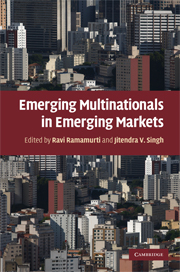13 - What have we learned about emerging-market MNEs?
from Part III - Conclusions
Published online by Cambridge University Press: 03 July 2009
Summary
We began this project with three research questions: What competitive advantages do EMNEs leverage as they internationalize, and how are those advantages shaped by the home-country context? How do EMNEs internationalize, and why? And, how is the rise of EMNEs affecting global industry dynamics? Underlying those questions was the theoretical question of whether existing IB frameworks are adequate to explain EMNE behavior, and if not, how they should be modified or extended.
The studies in Part II show clearly that EMNEs are not a homogeneous group by any means. The countries from which they hail, the industries in which they operate, the competitive advantages they exploit, the markets they target, and the internationalization paths they follow vary quite widely. The evidence does not permit sweeping generalizations about EMNEs nor about how they are different from MNEs that came before, because the latter is also a heterogeneous group.
Equally important, EMNEs have internationalized in a different international context than MNEs that came before, including even Japanese and Korean MNEs, and this makes inter-temporal comparisons even more difficult. Since the 1990s, the international policy environment and the technological environment have changed profoundly. Domestic and foreign markets were more open in this period than in earlier decades, following the collapse of Communism, the conclusion of the Uruguay Round trade deal, and the creation of the WTO.
- Type
- Chapter
- Information
- Emerging Multinationals in Emerging Markets , pp. 399 - 426Publisher: Cambridge University PressPrint publication year: 2009
References
- 116
- Cited by



